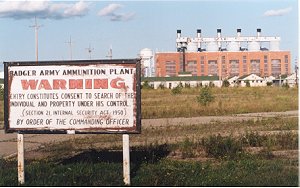
US Army Recants Promise to Test for All Explosives at Badger Ammunition Plant
Citizens for Safe Water Around Badger
MERRIMAC, WI (July 26, 2021) — The 300-acre Settling Ponds Area (above) spans more than 2 miles along the southern boundary of the former Badger Army Ammunition Plant. During active production years, these ponds received sanitary and industrial wastewater from the entire facility and surface runoff from the Nitroglycerine, Rocket Paste, and Magazine areas. Contaminated sediment removed during dredging operations were placed alongside the ponds and wetlands have been mapped throughout the area.
Last year, on August 26-27, a prescribed burn in the former Settling Ponds ignited an “unknown substance” under the ground, according to the WDNR. Residents on nearby Keller Road were informed of a voluntary evacuation order soon after. According to the WDNR, “observed subsurface fires/reactions were within the area of Settling Pond 2.”The land where the fire occurred is currently owned by the WDNR.
Months later, at a public meeting of the Badger Restoration Advisory Board, US Army representative Randy Cerar promised that pending soil investigations at the Settling Ponds would include the full suite of every chemical that has been detected at Badger, confirming that soil testing would include all six isomers (forms) of the toxic explosive DNT (dinitrotoluene).
In a surprising July 14 email to CSWAB, US Army representative Bryan Lynch recanted this commitment, writing: “There are only standards and methods for 2,4 and 2,6 DNT, so that is what we sampled for in the settling pond soil.”

However, the Army’s statement is inaccurate — there ARE methods and standards…
TEST METHODS FOR ALL SIX (6) DNTs ARE COMMERCIALLY AVAILABLE
A quick Internet search confirmed that methods for testing soil for all six isomers of DNT are readily available. A unit price quote for analysis of the six DNT isomers by SW846 8321A is posted here. Analysis can be performed by the Eurofins TestAmerica lab in Arvada, Colorado.
WI HAS ENFORCEABLE GROUNDWATER STANDARDS FOR ALL SIX (6) DNTs
Wisconsin’s Groundwater Enforcement Standard of 50 ppt (parts per trillion) is based on the summed-total concentration of all 6 isomers of DNT (not just 2).
Manufactured technical grade DNT is a mixture composed of approximately 76% 2,4-DNT, 19% 2,6-DNT, and 5% other DNT isomers (3,4-DNT, 2,3-DNT, 2,5-DNT, and 3,5 DNT). However, in groundwater at and near Badger Army Ammunition Plant, these isomers can be found independently and in much different ratios. See test results that illustrate this pattern here.
In December 2012, the WDNR reported that statewide, the 2,3-DNT isomer had been detected in 103 groundwater and private water wells at concentrations as high as 2,200 ppb. The 3,4-DNT isomer had been detected in 37 wells at levels as high as 419 ppb. The 3,5-DNT isomer had been detected in 20 wells at concentrations as high as 23.9 ppb and the 2,5-DNT isomer has been detected in wells at concentrations as high as 1.5 ppb.
ALL SIX (6) FORMS OF DNT ARE TOXIC
In June 2007, the Wisconsin Division of Health formally reported to WDNR: “All DNT isomers are capable of inducing cyanosis secondary to methemoglobin formation. At high doses, this is the critical effect that can lead to death. Target tissues include the hematopoetic system, the central nervous system and the male reproductive system. TG DNT, as well as 2,4- and 2,6-DNT are known to cause cancer in animals. Minor isomers have not been tested for this effect. All isomers have shown mutagenic effects in short-term studies. In order to protect against adverse health effects that can result from long-term exposure to DNT, a single health advisory for the summed concentration of all DNT isomers is proposed.”
WDNR CAN SET ENFORCEABLE SITE-SPECIFIC SOIL CLEANUP GOALS
In accordance with WDNR regulations, risk to groundwater is not the only factor in setting enforceable site-specific cleanup goals for soil. Wisconsin Administrative Code NR720 is very specific in this regard. Among these requirements are consideration of exposures via inhalation, dermal absorption and incidental ingestion. Additionally, residual soil contamination may not adversely affect surface water, fisheries or sensitive environments (such as via stormwater runoff). Soil contaminants may also not concentrate through plant uptake and adversely affect the food chain and may not result in vapor concentrations reaching a substance’s lower explosive (sic) limit.
DON’T LOOK, DON’T FIND
All 6 forms of DNT have been found in our groundwater. Why is the Army balking at testing the soil too? Learn more about the connection between cleanup and future use of the Badger lands here.

HOW TO HELP
Watch for future updates – your participation in upcoming public meetings will be important.
Contact your US Congressional representatives and ask them to support testing for ALL 6 forms of the explosive DNT at Badger and other contaminated military sites nationwide. Find your federal representatives here.
REFERENCE DOCUMENTS
Dinitrotoluenes WI Health Advisory Levels Memo 2007
DNT Lesser Isomers only Detected in DBG Wells Dec 2012 pdf
Settling Ponds Area Map AFS August 2012
Settling Ponds with Wetlands Acreage Map Badger Army
CSWAB Fact Sheet Soil Cleanup and Land Use FINAL 2015Test America Quote Soil Testing All 6 DNTs for CSWAB July 2021